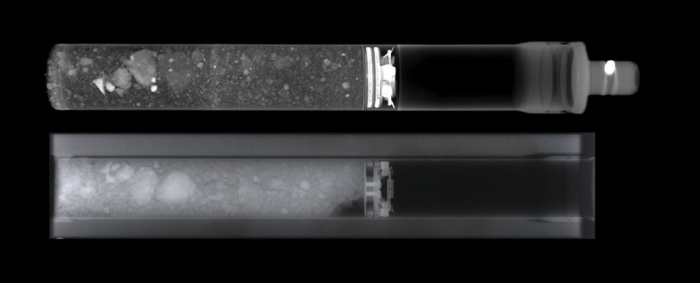The sample of regolith (a top layer of rock and soil) called sample 73002, was unsealed on 5 November. It was collected by Apollo 17 astronauts Gene Cernan and Jack Schmitt back in December 1972, by driving a 4-centimetre (1.6-inch) tube into the lunar surface.
And NASA is hoping that taking all these years to wait and analyse the majority of Moon regolith samples it has in storage will pay off: today's scientists have access to a host of tools and techniques that weren't available back in the 1970s.
"We are able to make measurements today that were just not possible during the years of the Apollo program," says planetary geologist Sarah Noble, from the NASA Apollo Next-Generation Sample Analysis (ANGSA) program.
"The analysis of these samples will maximise the science return from Apollo, as well as enable a new generation of scientists and curators to refine their techniques and help prepare future explorers for lunar missions anticipated in the 2020s and beyond."
The techniques that NASA scientists now have access to include non-destructive 3D imaging, mass spectrometry (scanning using ionised atoms or molecules), and ultra-high resolution microtomy (cutting samples up into ultra-thin slices) – in other words, we can study these rocks in much more detail.
Scientists ran a high-resolution 3D scan of sample 73002 before it was opened (top image below), enabling them to work out the best way of removing the precious regolith and distributing it to various research teams at NASA.
The scan below it was taken in 1974.
As you can imagine, the rock fragments are handled very carefully – they're first broken out of their casing in a case filled with ultra-pure dry nitrogen to avoid any contamination from the open air.
Part of the reason why more samples are being opened now – number 73001 will be analysed in early 2020 – is that NASA is preparing to send astronauts back to the Moon sometime in 2024.
Those astronauts will be collecting a whole new set of samples while touring the lunar surface, giving scientists the perfect opportunity to ask some follow-up questions from the findings revealed by samples 73002 and 73001.
The newly opened samples might also help point astronauts to spots on the Moon worthy of further investigation. According to NASA, the regolith could provide clues to the location of polar ice deposits on the Moon, shed light on how the Moon's crust has evolved over time, and help scientists better understand how landslides occur on the Moon's surface.
Furthermore, inspecting these samples taken decades ago could give scientists pointers about how to improve the rock-collecting tools that will be fitted to the spacecraft built for the 2024 Artemis mission.
The next batch of samples should tell us even more, but there's still plenty more to learn from the ones already in NASA storage.
"I grew up on the stories of Apollo, they inspired me to pursue a career in space and now I have an opportunity to contribute to the studies that are enabling the next missions to the Moon," says astromaterials curator Charis Krysher, who opened sample 73002 – and who has one of the coolest job titles we've ever come across.
"To be the one to open a sample that hasn't been opened since it was collected on the Moon is such an honour and heavy responsibility, we're touching history."
More about: #NASA
















































